|
|
|
Sort Order |
|
|
|
Items / Page
|
|
|
|
|
|
|
| Srl | Item |
| 1 |
ID:
109913
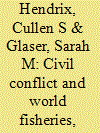

|
|
|
|
|
| Publication |
2011.
|
| Summary/Abstract |
While the negative economic consequences of civil conflict are well known, does civil conflict have sector-specific effects that threaten food and economic security? This article surveys the effects of civil conflict on reported marine and inland fish catch, focusing on the effects of conflict through redeployment of labor, population displacement, counter-insurgency strategy and tactics, and third-party encroachment into territorial waters. Analysis of 123 countries from 1952 to 2004 demonstrates a strong, statistically robust and negative relationship between civil conflict and fisheries, with civil wars (1000+ battle deaths) depressing catch by over 16% relative to prewar levels. The magnitude of this effect is large: the cumulative contraction in total fish catch associated with civil war onset is roughly 13 times larger than the estimated effect of an extraordinarily strong El Niño, the ocean-atmosphere phenomenon associated with global declines in fisheries. Robust evidence of a Phoenix effect is lacking: post-conflict fisheries do not quickly bounce back to prewar catch levels due to more rapid growth. Analysis of conflict episodes indicates that conflict intensity, measured by battle deaths, negatively affects fish catch, while population displacement and conflict proximity to the coast do not. While these findings contribute to the growing literature on the economic effects of civil conflict, they also are important for regional fisheries management organizations, which must increasingly pay attention to sociopolitical factors that dramatically affect the utilization of aquatic resources.
|
|
|
|
|
|
|
|
|
|
|
|
|
|
|
|
| 2 |
ID:
110804
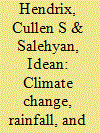

|
|
|
|
|
| Publication |
2012.
|
| Summary/Abstract |
Much of the debate over the security implications of climate change revolves around whether changing weather patterns will lead to future conflict. This article addresses whether deviations from normal rainfall patterns affect the propensity for individuals and groups to engage in disruptive activities such as demonstrations, riots, strikes, communal conflict, and anti-government violence. In contrast to much of the environmental security literature, it uses a much broader definition of conflict that includes, but is not limited to, organized rebellion. Using a new database of over 6,000 instances of social conflict over 20 years - the Social Conflict in Africa Database (SCAD) - it examines the effect of deviations from normal rainfall patterns on various types of conflict. The results indicate that rainfall variability has a significant effect on both large-scale and smaller-scale instances of political conflict. Rainfall correlates with civil war and insurgency, although wetter years are more likely to suffer from violent events. Extreme deviations in rainfall - particularly dry and wet years - are associated positively with all types of political conflict, though the relationship is strongest with respect to violent events, which are more responsive to abundant than scarce rainfall. By looking at a broader spectrum of social conflict, rather than limiting the analysis to civil war, we demonstrate a robust relationship between environmental shocks and unrest.
|
|
|
|
|
|
|
|
|
|
|
|
|
|
|
|
| 3 |
ID:
157848


|
|
|
|
|
| Summary/Abstract |
Does oil hinder democracy? The prevailing wisdom holds that, since 1980, oil has hindered democracy by enabling oil wealth to flow to state-owned oil companies, breaking the fiscal contract with society, and endowing oil-rich regimes with means to invest in repression and accommodation. However, these arguments do not account for system-level factors that might affect the oil-democracy relationship. I argue that a structural break in the oil-democracy relationship occurred at the end of the Cold War when the United States and the Soviet Union reduced support for both oil-poor and oil-rich authoritarian regimes in the developing world. The rollback of support facilitated post–Cold War democratization of the resource-poor regimes, while oil-rich regimes were better positioned to stave off pressures to democratize. Based on a re-analysis of two prominent studies, I find the oil curse to be a post–Cold War phenomenon, with negative consequences for democracy of a magnitude roughly 80 percent larger than previously estimated. I further explore these dynamics via comparative case studies of Azerbaijan and Georgia. The evidence shows that the oil curse is a function of geopolitical dynamics, not just international market conditions.
|
|
|
|
|
|
|
|
|
|
|
|
|
|
|
|
| 4 |
ID:
167276
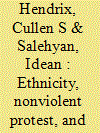

|
|
|
|
|
| Summary/Abstract |
Why do governments use deadly force against unarmed protesters? The government’s threat perception may be a function of the mobilization potential of the opposition and/or the size of the ruling elite’s support coalition. Given the high salience of ethnicity in African politics, governments that depend on small ethnic coalitions will see peaceful protests as more threatening, as the opposition may be able to draw on larger numbers of potential dissidents and excluded groups. Alternately, governments with larger, more homogeneous ethnic coalitions will find nonviolent mobilization less threatening and will be less likely to respond with deadly force. Using the Social Conflict Analysis Database, we demonstrate that as the size – and to a lesser extent homogeneity – of the ethnic ruling coalition grows, governments are significantly less likely to use deadly force against nonviolent protesters. This finding is robust to several operationalizations of the size of the government’s support coalition, the inclusion of other measures of ethnic demographics, and estimators that account for the hierarchical nature of the data. Threat perception hinges not only on dissident tactics but on their demands, their mobilization potential, and their capacity to impose costs on the government. This article demonstrates that the size and composition of the government’s ethnic support base matters as well.
|
|
|
|
|
|
|
|
|
|
|
|
|
|
|
|
| 5 |
ID:
109228


|
|
|
|
|
| Publication |
2011.
|
| Summary/Abstract |
This article expands on the conventional discourse relating rough terrain - mountainous terrain and noncontiguous territory - to civil war onset. In addition to their direct effects on the strategic and tactical logic of insurgency, I argue these factors affect state capacity, as measured by tax capacity, and exert an indirect effect through this channel. Because tax capacity proxies bureaucratic and administrative capacity as well as material resources, it conditions the decision to rebel more than military capacity per se. I find a negative relationship between mountainous terrain and to a lesser extent, noncontiguous territory, and state capacity. Subsequently, I find tax capacity is strongly and negatively associated with civil war onset, though this relationship appears only with longer than conventional temporal lags. The cumulative (direct + indirect effects mediated by state capacity) of rough terrain is roughly 45 per cent larger than its direct effect.
|
|
|
|
|
|
|
|
|
|
|
|
|
|
|
|
| 6 |
ID:
155186
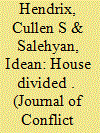

|
|
|
|
|
| Summary/Abstract |
Why do African regimes repress certain contentious challenges but not others? We argue that in addition to opposition claims and tactics, African regimes are especially likely to view challenges expressing ethnic and/or religious claims as threatening. However, in theorizing the decision to use repression, we relax the assumption that the state is a unitary actor. Leaders with a history of factionalism in their security forces face a delegation problem: orders to repress may not be followed or could even cause intraregime violence and/or defections. For this reason, states with divided security forces are less likely to enact repression. This potential for fracturing the regime will be greatest when the challenge has ethnic or religious claims and targets the state, implying an interactive effect. Using the Social Conflict in Africa Database, we find that regimes with a history of past military factionalism are generally less likely to use repression and are especially less likely to repress contentious challenges making ethnic or religious claims.
|
|
|
|
|
|
|
|
|
|
|
|
|
|
|
|
| 7 |
ID:
171803
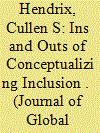

|
|
|
|
|
| Summary/Abstract |
In the field of global security studies, inclusion, both in terms of process and outcomes, is certainly having a moment. Like many terms widely adopted by the international security and development communities, the utility of the discourse around inclusion stems in part from its ambiguity. The various contributions to this special issue make good and productive use of this ambiguity and have moved the discussion of inclusive approaches to governance, violence reduction, and peace-building forward. In doing so, however, they have put forth very different conceptualizations and operationalizations of inclusion and exclusion. Thus, my contribution to this symposium identifies these various conceptualizations, discusses the strengths and weaknesses of proposed measures, and concludes with remarks on the normative implications of these analyses.
|
|
|
|
|
|
|
|
|
|
|
|
|
|
|
|
| 8 |
ID:
097766


|
|
|
|
|
| Publication |
2010.
|
| Summary/Abstract |
This article identifies and addresses key conceptual and measurement issues raised by measures of state capacity in studies of civil conflict. First, it reviews competing definitions and operationalizations of state capacity, focusing specifically on those that emphasize (1) military capacity, (2) bureaucratic administrative capacity, and (3) the quality and coherence of political institutions. Second, it critically assesses these measures on the basis of construct validity, focusing attention on whether they accurately capture the theoretical concept of state capacity, and whether they allow the researcher to differentiate between competing causal mechanisms. Third, it employs principal factor analysis to identify the underlying dimensionality of 15 different operationalizations of state capacity. State capacity is characterized by low dimensionality, with three factors - or dimensions of state capacity - explaining over 90% of the variance in the 15 measures. While the first factor, rational legality, captures bureaucratic and administrative capacity, the second, rentier-autocraticness, and third, neopatrimoniality, capture aspects of state capacity that cut across theoretical categories. The article concludes by suggesting a multivariate approach to modeling state capacity, and that (1) survey measures of bureaucratic quality, and (2) tax capacity are the most theoretically and empirically justified.
|
|
|
|
|
|
|
|
|
|
|
|
|
|
|
|
| 9 |
ID:
132394
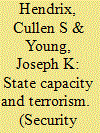

|
|
|
|
|
| Publication |
2014.
|
| Summary/Abstract |
Conventional wisdom suggests that dissident groups use terrorism when they face an overwhelmingly more powerful state, yet attacks in developing countries have predominated in the post-Cold War era, suggesting that terrorism is an increasingly weak state phenomenon. Cross-national studies of terrorism find mixed results for how common measures of state capacity influence terrorism. We argue that these indeterminate findings are due in part to a partial understanding of both what constitutes state capacity and how different aspects of state strength or weakness relate to the propensity of groups to use terrorism. We decompose state capacity into two dimensions that we theorize are particularly relevant to dissident groups: military capacity, or the ability to project conventional military force, and bureaucratic/administrative capacity. Our analysis supports the claim that terrorist attacks are more frequently targeted at states with large, technologically sophisticated militaries but less frequently targeted at states with higher bureaucratic and administrative capacity. We also compare two militarily capable states, France and Russia, that have had different recent experiences with terrorism to help illustrate the causal mechanisms involved. Evidence from our models and cases suggest that states can be capable in different ways, and these various capabilities create differing incentives for using terror as a strategic and tactical tool.
|
|
|
|
|
|
|
|
|
|
|
|
|
|
|
|
| 10 |
ID:
167664


|
|
|
|
|
| Summary/Abstract |
This article investigates the factors that affect scholarly attention on particular countries in four major international relations (IR) journals: International Studies Quarterly, International Organization, International Security, and World Politics for the period 1970 to the present. The analysis supports three basic conclusions. First, the United States receives the most scholarly attention in leading IR journals by a large margin. Second, a baseline model of scholarly attention, including just population, gross domestic product (GDP), and a dummy for the United States fits the data rather well. Additional factors such as membership in prominent international organizations or involvement in armed conflicts improve model fit, but only marginally, with little evidence of regional or English-language bias. And third, there is only weak evidence that countries with stronger economic and security linkages with the United States receive more attention. However, Israel and Taiwan—two countries with unique security relationships with the United States—receive more scholarly attention than either the baseline or augmented models would predict. Our analysis of bibliometric data from leading IR journals indicates the United States is the three-hundred-thousand-pound blue whale of IR scholarship. However, this emphasis is not particularly outsized when its large population, economy, and its extensive history of participation in interstate wars are taken into account.
|
|
|
|
|
|
|
|
|
|
|
|
|
|
|
|
|
|
|
|
|